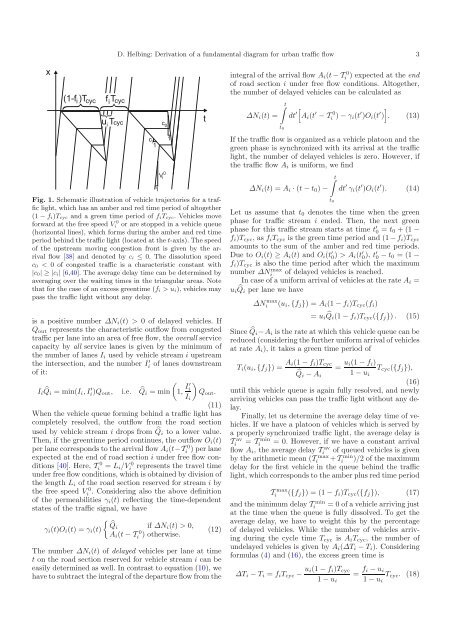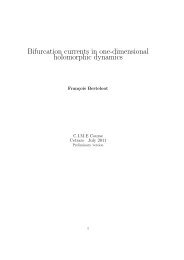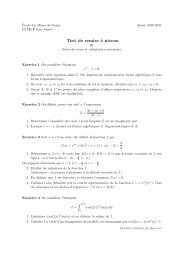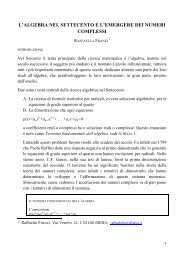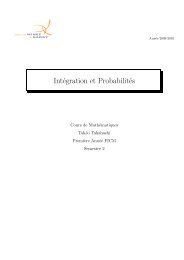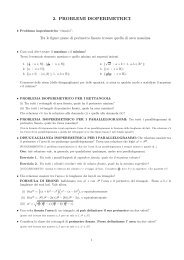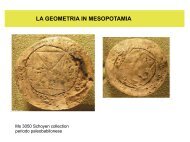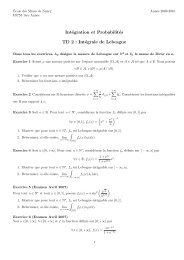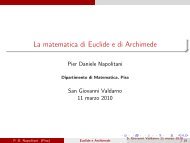Derivation of a fundamental diagram for urban traffic flow
Derivation of a fundamental diagram for urban traffic flow
Derivation of a fundamental diagram for urban traffic flow
You also want an ePaper? Increase the reach of your titles
YUMPU automatically turns print PDFs into web optimized ePapers that Google loves.
D. Helbing: <strong>Derivation</strong> <strong>of</strong> a <strong>fundamental</strong> <strong>diagram</strong> <strong>for</strong> <strong>urban</strong> <strong>traffic</strong> <strong>flow</strong> 3<br />
integral <strong>of</strong> the arrival <strong>flow</strong> A i (t −Ti 0 ) expected at the end<br />
<strong>of</strong> road section i under free <strong>flow</strong> conditions. Altogether,<br />
the number <strong>of</strong> delayed vehicles can be calculated as<br />
Fig. 1. Schematic illustration <strong>of</strong> vehicle trajectories <strong>for</strong> a <strong>traffic</strong><br />
light, which has an amber and red time period <strong>of</strong> altogether<br />
(1 − f i)T cyc and a green time period <strong>of</strong> f iT cyc. Vehicles move<br />
<strong>for</strong>ward at the free speed Vi<br />
0 or are stopped in a vehicle queue<br />
(horizontal lines), which <strong>for</strong>ms during the amber and red time<br />
period behind the <strong>traffic</strong> light (located at the t-axis). The speed<br />
<strong>of</strong> the upstream moving congestion front is given by the arrival<br />
<strong>flow</strong> [38] and denoted by c i ≤ 0. The dissolution speed<br />
c 0 < 0 <strong>of</strong> congested <strong>traffic</strong> is a characteristic constant with<br />
|c 0|≥|c i| [6,40]. The average delay time can be determined by<br />
averaging over the waiting times in the triangular areas. Note<br />
that <strong>for</strong> the case <strong>of</strong> an excess greentime (f i >u i), vehicles may<br />
pass the <strong>traffic</strong> light without any delay.<br />
is a positive number ΔN i (t) > 0 <strong>of</strong> delayed vehicles. If<br />
Q out represents the characteristic out<strong>flow</strong> from congested<br />
<strong>traffic</strong> per lane into an area <strong>of</strong> free <strong>flow</strong>, the overall service<br />
capacity by all service lanes is given by the minimum <strong>of</strong><br />
the number <strong>of</strong> lanes I i used by vehicle stream i upstream<br />
the intersection, and the number I i ′ <strong>of</strong> lanes downstream<br />
<strong>of</strong> it:<br />
( )<br />
I i ̂Qi =min(I i ,I i ′ )Q out, i.e. ̂Qi =min 1, I′ i<br />
Q out .<br />
I i<br />
(11)<br />
When the vehicle queue <strong>for</strong>ming behind a <strong>traffic</strong> light has<br />
completely resolved, the out<strong>flow</strong> from the road section<br />
used by vehicle stream i drops from ̂Q i to a lower value.<br />
Then, if the greentime period continues, the out<strong>flow</strong> O i (t)<br />
per lane corresponds to the arrival <strong>flow</strong> A i (t−Ti 0)perlane<br />
expected at the end <strong>of</strong> road section i under free <strong>flow</strong> conditions<br />
[40]. Here, Ti 0 = L i /Vi<br />
0 represents the travel time<br />
under free <strong>flow</strong> conditions, which is obtained by division <strong>of</strong><br />
the length L i <strong>of</strong> the road section reserved <strong>for</strong> stream i by<br />
the free speed Vi 0 . Considering also the above definition<br />
<strong>of</strong> the permeabilities γ i (t) reflecting the time-dependent<br />
states <strong>of</strong> the <strong>traffic</strong> signal, we have<br />
{ ̂Qi if ΔN<br />
γ i (t)O i (t) =γ i (t)<br />
i (t) > 0,<br />
A i (t −Ti 0)otherwise.<br />
(12)<br />
The number ΔN i (t) <strong>of</strong>delayed vehicles per lane at time<br />
t on the road section reserved <strong>for</strong> vehicle stream i can be<br />
easily determined as well. In contrast to equation (10), we<br />
have to subtract the integral <strong>of</strong> the departure <strong>flow</strong> from the<br />
ΔN i (t) =<br />
∫ t<br />
dt ′[ ]<br />
A i (t ′ −Ti 0 ) − γ i(t ′ )O i (t ′ ) . (13)<br />
t 0<br />
If the <strong>traffic</strong> <strong>flow</strong> is organized as a vehicle platoon and the<br />
green phase is synchronized with its arrival at the <strong>traffic</strong><br />
light, the number <strong>of</strong> delayed vehicles is zero. However, if<br />
the <strong>traffic</strong> <strong>flow</strong> A i is uni<strong>for</strong>m, we find<br />
∫ t<br />
ΔN i (t) =A i · (t − t 0 ) −<br />
t 0<br />
dt ′ γ i (t ′ )O i (t ′ ). (14)<br />
Let us assume that t 0 denotes the time when the green<br />
phase <strong>for</strong> <strong>traffic</strong> stream i ended. Then, the next green<br />
phase <strong>for</strong> this <strong>traffic</strong> stream starts at time t ′ 0 = t 0 +(1−<br />
f i )T cyc ,asf i T cyc is the green time period and (1 − f i )T cyc<br />
amounts to the sum <strong>of</strong> the amber and red time periods.<br />
Due to O i (t) ≥ A i (t) andO i (t ′ 0) >A i (t ′ 0), t ′ 0 − t 0 =(1−<br />
f i )T cyc is also the time period after which the maximum<br />
number ΔNi<br />
max <strong>of</strong> delayed vehicles is reached.<br />
In case <strong>of</strong> a uni<strong>for</strong>m arrival <strong>of</strong> vehicles at the rate A i =<br />
u i ̂Qi per lane we have<br />
ΔNi max (u i , {f j })=A i (1 − f i )T cyc (f i )<br />
= u i ̂Qi (1 − f i )T cyc ({f j }) . (15)<br />
Since ̂Q i −A i is the rate at which this vehicle queue can be<br />
reduced (considering the further uni<strong>for</strong>m arrival <strong>of</strong> vehicles<br />
at rate A i ), it takes a green time period <strong>of</strong><br />
T i (u i , {f j })= A i(1 − f i )T cyc<br />
= u i(1 − f i )<br />
T cyc ({f j }),<br />
̂Q i − A i<br />
1 − u i<br />
(16)<br />
until this vehicle queue is again fully resolved, and newly<br />
arriving vehicles can pass the <strong>traffic</strong> light without any delay.<br />
Finally, let us determine the average delay time <strong>of</strong> vehicles.<br />
If we have a platoon <strong>of</strong> vehicles which is served by<br />
a properly synchronized <strong>traffic</strong> light, the average delay is<br />
Ti<br />
av = Ti<br />
min = 0. However, if we have a constant arrival<br />
<strong>flow</strong> A i , the average delay T av <strong>of</strong> queued vehicles is given<br />
i<br />
by the arithmetic mean (Ti<br />
max +Ti<br />
min )/2 <strong>of</strong>themaximum<br />
delay <strong>for</strong> the first vehicle in the queue behind the <strong>traffic</strong><br />
light, which corresponds to the amber plus red time period<br />
T max<br />
i ({f j })=(1− f i )T cyc ({f j }), (17)<br />
and the minimum delay Ti<br />
min = 0 <strong>of</strong> a vehicle arriving just<br />
at the time when the queue is fully dissolved. To get the<br />
average delay, we have to weight this by the percentage<br />
<strong>of</strong> delayed vehicles. While the number <strong>of</strong> vehicles arriving<br />
during the cycle time T cyc is A i T cyc ,thenumber<strong>of</strong><br />
undelayed vehicles is given by A i (ΔT i − T i ). Considering<br />
<strong>for</strong>mulas (4) and(16), the excess green time is<br />
ΔT i − T i = f i T cyc − u i(1 − f i )T cyc<br />
1 − u i<br />
= f i − u i<br />
1 − u i<br />
T cyc . (18)


